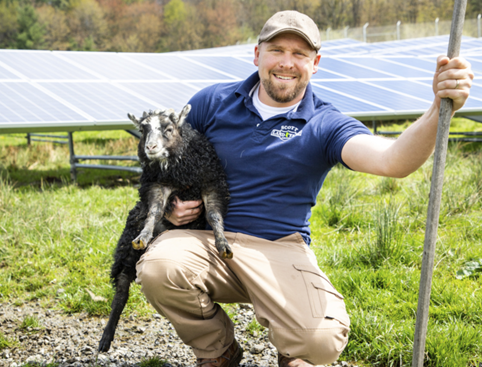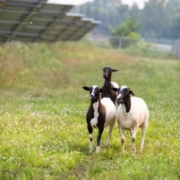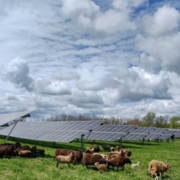Case Study: Caleb Scott, United Agrivoltaics
In 2012, Caleb Scott was working with solar developers to help seed and build sites. As he got more involved in the industry, his job expanded to help properly maintain these sites. Scott began mowing the solar sites but quickly realized it was a challenging task. Every site was different, with varying degrees of ground levelness, infrastructure spacing, and site vegetation-management requirements. Additionally, he had to be careful around the panels to avoid any damage from his equipment.
When not working on-site, Scott, a seventh-generation farmer, took care of his flock of sheep. He realized that sheep would do a much better job at vegetation management than mowers and would get around easier. However, despite his experience in managing sheep and solar vegetation, it was difficult to convince the industry that sheep could be a valuable form of vegetation management. Scott began to work with Cornell University to collaborate with solar developers and use the University’s property to perform a demonstration site for solar grazing. This work gave him proof of concept, and he began grazing on solar sites in 2013.

Caleb Scott of United Agrivoltaics at a solar site. Photo: Caleb Scott
After Scott received his first solar grazing contract, he was able to grow and strengthen his practice. In addition to being a founding board member of the American Solar Grazing Association, he also created United Agrivoltaics, one of the first and oldest agrivoltaic sheep-grazing firms in the U.S. United Agrivoltaics functions as a co-operative to promote expansion of the solar grazing industry and now has 103 sites in nine states. The organization uses Scott’s unique background to provide vegetation management with solar grazing, as well as consulting to implement agrivoltaics on solar projects.
Scott and the other 80+ graziers involved with United Agrivoltaics pride themselves on creating a healthy, shared-use system. While their specialty is in solar grazing with sheep, they have also used chickens, turkeys, rabbits, and pigs to help maintain the site vegetation and increase the overall productivity of the site. Scott uses three different styles of grazing: mob, rotational, and low-impact sustained grazing. These management methods provide financial benefits in some cases and health benefits in others. Scott’s main priority when deciding which style to use depends on what is going to work best for the on-site forage content, as well as for his farm and animals.
United Agrivoltaics recognizes the variability between sites and offers different tiers of service to help overcome this. This is a major benefit for asset owners as it allows them to form a contract and relationship with one party for all their site-management needs. Scott’s full management package includes services such as exterior perimeter mows, spraying herbicide as needed to control noxious or invasive species, and a clean-up mow to manage the vegetation the sheep did not eat.
The flexibility of United Agrivoltaics’ services has helped the organization grow over time. They are currently grazing 15,000 sheep on more than 5,100 acres of solar sites, with a goal to double the number of sheep in the upcoming year. Scott himself is grazing 650 sheep on 200 acres, and this growth allowed solar grazing to become his full-time job. He and United Agrivoltaics have purchased and acquired other companies along the way to help them grow.
As United Agrivoltaics continues to expand, they ensure that their services remain competitive with the costs of mechanical mowing. The grazing costs will vary depending on location and which rating scale the site owner chooses for their site. In an area with farm readiness considerations being met, fees can range from $380/acre for the full management package to more than $1,500/acre. Despite the large range in pricing, Scott recognizes that generalizing pricing would have a negative impact on the solar grazing industry due to the number of variables that determine contract pricing, such as site management requirements and feasibility for the grazier.

A trio of sheep on a solar site. Photo: American Solar Grazing Association
In addition to difficulties associated with selecting the correct pricing for a site, insurance can be an added challenge when solar grazing, as extra costs typically do not outweigh the value of the contract. One of Scott’s biggest initial challenges in the solar grazing industry was learning to manage the site as dictated by the contract. In some cases, he has had to change his vision of what he thinks the site should look like in order to meet the site owner’s needs. Farming motives can differ from solar operation motives and requires calculating the correct stocking densities.
To help overcome these challenges, Scott’s advice is to reach out and talk to someone who has done it before to ask a lot of questions and educate yourself.
“This industry requires a lot of teamwork, especially since the solar grazing industry is so young and we have so few sheep in the country. We need to help and support one another.” — Caleb Scott.
Teaming up with individuals who have prior experience could allow for sharing things like insurance (costs), equipment, and other resources, which could mean saving additional money. It is also beneficial to discuss contracts with those who have experience. Scott recommends finding an organization, like ASGA, that helps farmers and joining them to learn and share ideas.
This teamwork represents Scott’s overall goal for the solar grazing industry and United Agrivoltaics, which is to have as many sheep in the organization as are currently in the U.S. right now–over 3 million. He wants to accomplish this by expanding his company and farming group nationwide. By doing so, he hopes to see the sheep industry increase tenfold in the next 20 years, and he wants to be a part of that change. If this were to be accomplished, it would undoubtedly afford tremendous benefits for the solar-grazing industry.



